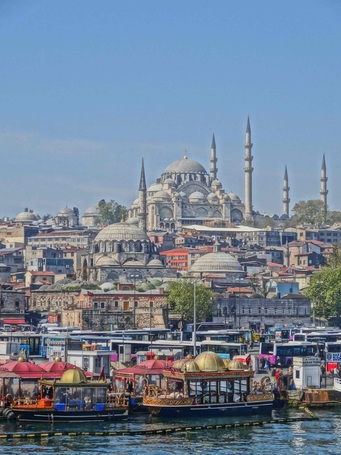 View of Rustem Pasha Mosque
View of Rustem Pasha Mosque 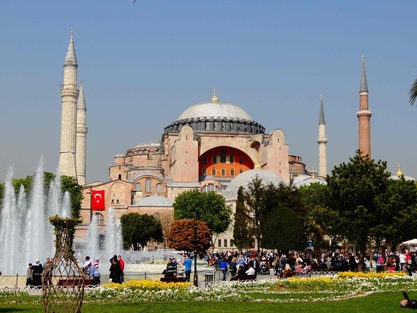 Hagia Sophia
Hagia Sophia 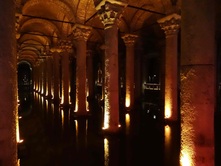
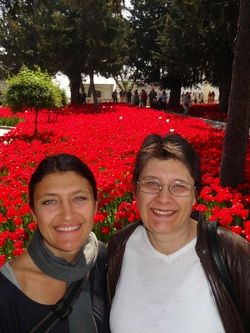
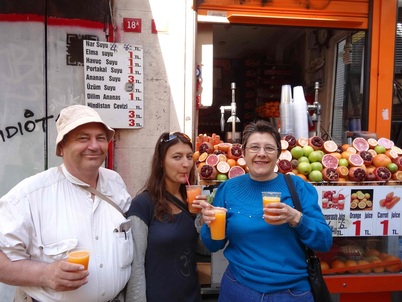
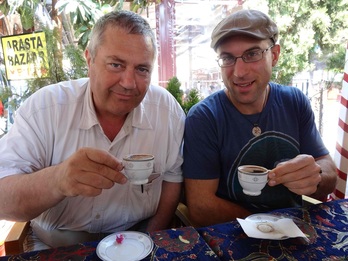 Turkish coffee goes great with sweets!
Turkish coffee goes great with sweets! 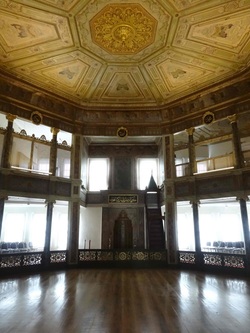 The Whirling Dervish Hall
The Whirling Dervish Hall 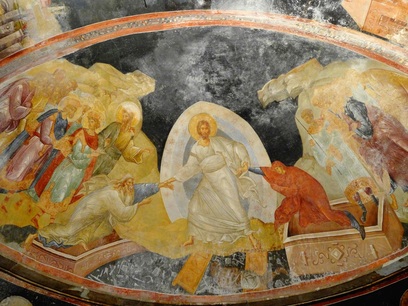 Righteous on my right, sinner on my left
Righteous on my right, sinner on my left 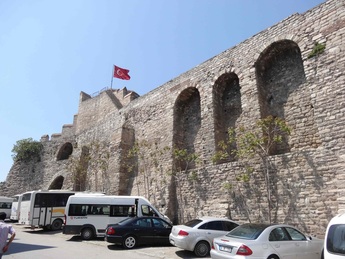
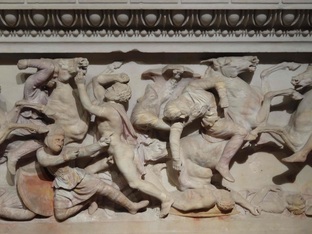
We embarked on our longest plane flight as we took the massive trip from Seoul to Istanbul, with 2 stopovers in China, for a total of 22 hours! Having completed the Eastern leg of our trip, the irony wasn’t lost on us that we flew into the only city that straddles two continents. One side of Istanbul sits in Europe while the other sits in Asia. So we were literally just a river’s width away from being back on the Asian continent! While the trip itself was exhausting, the end of it was joyful as we saw Petko & Nadia waiting for us as we emerged from customs at the airport. They had driven down to explore Istanbul with us and we were in for an action packed few days. Istanbul has a tremendous amount to see and do, having been the capital of the Byzantine Empire for 800 years and the Ottoman Empire for close to 500.  View of Rustem Pasha Mosque View of Rustem Pasha Mosque Our first day was to some of the city’s most spectacular sights. We walked across the Golden Horn (named after all the gold the Byzantines were said to have thrown into the harbor when Constantinople was being sacked by the Ottomans) to stunning views of the mosque lined old city. The New Mosque is the most conspicuous of the mosques along the waterfront and its construction is intermingled with two often oppressed groups: women and Jews. In this case the one was working against the other. The construction of the mosque was ordered by Safiye Sultan, the wife of Sultan Murad III during a time when women controlled much of the political affairs of the Ottoman Empire while the Sultans abdicated much of their power in favor of partying and enjoying their harems. Unfortunately, Safiye Sultan’s motivation in building the mosque was due to its location in the city’s foremost commercial center, where many Jewish merchants lived. Local and foreign merchants had grown jealous of the Jews’ success in the area so the building of a mosque was a convenient way to legally seize Jewish properties, a story we have seen in many other cities.  Hagia Sophia Hagia Sophia As we strolled through the city we came to perhaps its two most famous sites. Hagia Sophia and sitting right across from it, the Blue Mosque. Hagia Sophia is a masterpiece of world architecture, having been built in 537 and remaining the largest dome in the world for nearly a 1000 years while also being the seat of Byzantine Power during that time. Sultan Ahmed Mosque, or the Blue Mosque sits across from Hagia Sophia with a small park and water fountain in between them. It is a massive structure with 6 minarets (and issue of contention since the Grand Mosque in Mecca had 6 at the time and the Blue Mosque was seen as an egotistical challenge to its power) that is filled with Iznik tiles, a traditional ceramic painted in hues of primarily blue, white, and sometimes copper-red. We finished the day with a visit to the Mosaic Museum, where mosaics from the Great Palace of Constantinople have been unearthed and are on display.  At that point everyone was exhausted, but Jeff had energy for one more site as he headed down into the bowels of the city to explore the Basilica Cistern, an ancient water holding area built in the 6th century. It was capable of holding 100,000 tons of water in its hey-day and was an engineering marvel, containing 336 huge marble columns to support its cathedral sized chamber.  The next day we explored Topkapi Palace, the primary residence of the Ottoman Sultans for over 400 years. The complex is huge and it took us nearly an entire day to move among its courtyards and various buildings such as the King’s Harem, Audience Chamber, Library, and summer pavilions. It was particularly pleasant due to the lush tulips that were growing throughout the palace. Still, I couldn’t help a cringe when passing the circumcision room – dedicated to the deed for young princes. But I felt better for them after passing the beautiful apartment of the Crown Prince in the Royal Harems, where, according to the sign, the princes were trained in the “discipline” of the Ottoman Harem. We also visited the Grand Bazaar on this day, but were slightly disappointed on how it was essentially more of an over-priced indoor mall with aggressive shop-owners rather than an old style market selling anything close to authentic goods. For the most part we found this to be the case of any of the well-known markets.  Each day of our travels was an indulgence in different kinds of Turkish food. For Neda and me it was particularly refreshing to find so much fresh fruit, most of which Turkey grows itself. This is in contrast to places like Japan where fruit is imported and quite costly. For just $1.50 we could get a glass of fresh squeezed pomegranate juice and for only fifty cents a glass of orange juice. Sufficed to say, we drank a lot juice. The cuisine itself was mildly disappointing for us as it seemed quite greasy and didn’t compare favorable to Bulgarian cuisine, with which we are well acquainted. Meat dishes were generally just grilled (like meat kebabs) without much seasoning and the mezzes (side dishes) we tried were oily and not terribly interesting flavor-wise. Unfortunately we also struggled to find authentic cuisine because every restaurant in the city seems to be on tripadvisor and those where the locals are eat are usually just places with pre-cooked food being kept warm. You just enter and pick out the food you want. It’s cheap, but not exceptionally fresh or tasty.  Turkish coffee goes great with sweets! Turkish coffee goes great with sweets! In contrast to the main courses, the sweets were a highlight of our time in Istanbul. Local bakeries made melt-in-your mouth baklava at reasonable prices and the halva (a dense, flaky sweet made up primarily of tahini and sugar) was to die for! Often lunch for us would just be a sampling of different offerings at the bakery – real indulgence! If you’re going to Istanbul though, watch out for the popular tourist markets – there you’ll find overpriced baklava made with simple syrup instead of real honey, an experience better avoided.  The Whirling Dervish Hall The Whirling Dervish Hall Our 3rd day in Istanbul was generally considered the favorite by the family, though it started with two “misses”. The first was the Galata Mevlevi House, a Sufi lodge in the Whirling Dervish tradition. The order was originally founded by Jalal ad-Din Muhammad Rumi, one of Neda & my favorite poets and spiritual thinkers. Unfortunately, the “museum” did a first rate job of making Sufism uninteresting and included no audio or visual presentations of a tradition that has to be seen and heard to be understood. It also only has Dervish dances once a month, making it difficult to see an authentic version of the famous spinning dancers, who have been thoroughly commercialized in the city due to tourist interest. The second miss was a trip to the exceptional Church of St. Stephen the Bulgar, notable for being completely pre-fabricated of iron. That’s right, the whole church was made in Vienna and then shipped to Istanbul to be put up in the late 1800’s. It was only a miss because the whole church is closed for renovation.  Righteous on my right, sinner on my left Righteous on my right, sinner on my left The day started to redeem itself, however, with a trip to Church of the Holy Saviour in Chora. The beautiful Byzantine Church contains captivating murals built through the patronage of Byzantine statesman Theodore Metochites. The murals are the finest example of the Palaeologian Renaissance, which was a flowering of Byzantine art and culture after the sack of Constantinople by Venice. Eventually the city was won back by the Palaeologan dynasty, though it was permanently weakened in what would only be a prelude to the Ottoman conquest 150 year later. However, the sacking scattered Byzantine artists into various different regions so when they returned they incorporated the styles they had learned into the new murals. The result is more humanistic representations of the religious life of Jesus than can be found anywhere else in the Byzantine world. Once could see how the story of Christ’s life and the Virgin’s life would have seemed to come to life to parishioners practicing in the church at the time.  Just a few blocks from the church sit the famous Theodosian Walls that protected Istanbul from invasion for 1000 years. The walls repelled Arabs, Rus’ and Bulgar invaders over the years and was even able to repel cannon technology for a while (soldiers would rebuild the fortifications during reloading of the cannons!). Eventually the Ottomans overpowered them, but they still stand as one of the most important defensive structures of antiquity. For our part, a steep climb up the walls led to sweeping views of the city and worked up an appetite for a local lunch next to a mosque and some Turkish coffee afterwards! After the walls, our next activity was a beautiful cruise up the Bosphorus strait in the direction of the Black Sea. Along the way one passes beautiful palaces by Sultans, old fortresses used to attack the city, and riverhouses built by wealthy Ottoman citizens at the height of the empire. What better way to end our favorite day than going to a Turkish Coffeehouse, where Nadia & Pekto tried their first Hookah! Nadia picked the strawberry flavor and we all sipped on Linden tea while laughing good-naturedly at the parents’ attempt to master the smoking process.  Our last day was one of relaxation, shopping in the city’s bazaars, and visiting the Istanbul Archeological Museum. Some notable objects we enjoyed there were the world’s oldest love poem, the world first written peace treaty (dating from 1258BC), and some amazingly well preserved Sarcophagus’ from the 4th century BC, found in the area of ancient Sidon. The next day we headed out of town with a stopover close to the border at Edirne to see the famed Selimiye Mosque, a towering structure considered a high point of Islamic architecture. From there we crossed the border into Bulgaria! Neda & I joyfully ate our first shopska salad and Bulgarian kebabs in more than 6 months and appreciated being in a country where we could understand what was being said. This leg was our longest away from home taking us to India, Malaysia, New Zealand, Australia, Japan, and Korea. It is also our last major leg, as we don’t plan on doing any more traveling (other than around Bulgaria) and than heading back to the States in the next few months. Thanks for following our travels these past two years and stay-tuned for follow-up posts about lessons learned on the road!
0 Comments
Our last few posts have been focused on a combination of Zen & history as we traveled throughout Japan. There is no doubt that South Korea is full of both with its own tradition of Zen Buddhism as well as a fascinating history dating back to the era of the 3 Kingdoms and continuing through the Joseon dynasty, which was one of the most enduring monarchies in history. South Korea’s more modern history in the 20th century includes the Japanese occupation, the division of the peninsula after WWII and the ensuring war, as well as the country’s meteoric rise as an economic power would all be grist for a great post. But instead of all that we’re going to focus on something truly scrumptious – the delicious food! Bulgogi After a short flight on the absurdly cheap Peach Airlines from Osaka to Seoul (for $30/person!), our first stop upon getting into the city was for the famous Korean BBQ. If you’ve never been to a Korean BBQ restaurant before, its unique feature is that the meats are cooked at the table in front of you with a variety of vegetables and sauces. 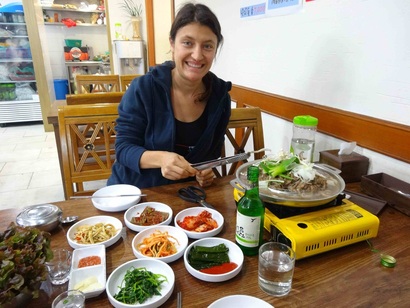 Our first bulgolgi in Korea! Our first bulgolgi in Korea! Our first dish might have had to be the heart of Korean BBQ – Bulgogi. Bulgogi is thinly sliced sirloin that has been marinated in a sauce consisting of soy sauce, sesame oil, minced garlic, pear juice, and a bit of sugar and spice. It cooks on a grill in front of you with green onions, carrot, onion, and mushroom. The result is a melt in your mouth experience that has been with Korean people since the time of the Goguryeo kingdom (37BC-668AD). It was immensely popular until Buddhist influence spread over the peninsula and the carnivorous dish took a backseat, only to be reintroduced with a vengeance when the Confucian-focused Joseon dynasty came to power in 1392. 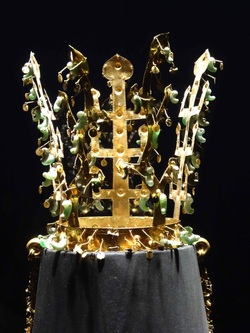 To learn a bit about Korea’s fascinating history, we headed over to the National Museum of Korea. There we saw an amazing gold crown made for the Kings of the Silla Kingdom (who defeated the Goguryeo Kingdom above with the help of the Chinese Tang dynasty). Its complex symbolism includes tree branches symbolizing the world and horns symbolizing reindeer. It also had little embryo shaped pieces of jade attached to it that may have symbolized fertility. The most impressive piece for us was a gracefully carved bronze “Pensive Buddha” which was also from the Silla Kingdom. Here, Prince Shakyamuni sits contemplating the world with one leg crossed on top of his thigh and his hand gently holding his head. To me it is like the Eastern counterpart of Rodin’s “The Thinker”. Interestingly, the Thinker is muscle bound and hunched over while the Pensive Buddha’s posture is fairly upright and his body thin. Do the two sculptures tell us something about the differences between the cultures of the West versus the East? Juk After the museum we headed down to Yeouido Park where we saw that our short hop on the plane had taken us right back into Cherry Blossom season! The Koreans weren’t quite as enthusiastic as the Japanese with their Hanami parties, but everyone was still enjoying the delicate blooms blowing in the wind along with the flavors of festival food. The next morning we tried out Korean rice-porridge, known as “juk”. This dish is pan-asian as rice is a common staple across the region, having been introduced by China thousands of years ago. Neda tried the beef and mushroom variety and I had crab and spring onion. While our expectations were high, we have to give the nod to the Thai version of the dish, which was much more flavorful owing to its high use of ginger, garlic, cilantro and spicy pepper! 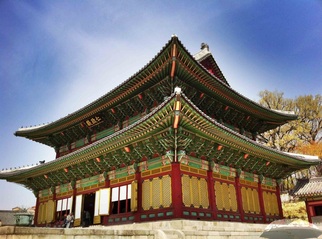 Changdeokgung Palace Throne Hall Changdeokgung Palace Throne Hall After our juk, we headed to Changdeokgung Palace where we were treated to two interesting guided tours of the grounds. First we saw the palace itself, which was constructed in 1405 as a secondary palace of the Joseon Dynasty. It burned during Japanese invasion in 1592, but was rebuilt in 1610. The throne room, King’s bedchamber, and other structures of the palace feature sweeping roofs and the forest-green and maroon color scheme of the royal family. Behind the palace lies a 78 acre “rear garden” with 300 year old trees and lotus ponds overlooking libraries and buildings the royalty used to host guests or just simply to write poetry or watch the moon. Pretty nice life! Kimchi The next day we decided to go a little deeper into Korean cuisine. We booked a class at the Food & Culture Korea Academy to learn how to make some of our favorites: Bulgolgi & Kimchi. To those of you familiar with Korean Cuisine, it might seem strange I didn’t mention it off the bat. The spicy fermented cabbage dish is a staple of the Korean diet, appearing as a side dish at practically every meal that we ate while in Seoul. In fact, one of the charming aspects about dining in Korea is the plethora of small sides that accompany every meal – from a simple breakfast to an elaborate dinner. You always have some kimchi, maybe some bean sprouts, tofu in spicy sauce, marinated beans, etc… 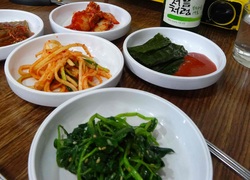 variety of kimchi variety of kimchi Kimchi is the show-stopper however. It doesn’t have to be cabbage, as there are hundreds of versions made with cucumbers, radishes, and other veggies. In fact, though the napa cabbage is the most ubiquitous type of kimchi, it wasn’t the first type made because the Chinese had yet to introduce the cabbage in the earliest years of production. Over 2,000 years ago, kimchi was produced for two major reasons: conservation and digestion. The cold winters in Korea and mountainous topography made whatever veggies that grew quite precious. So the Koreans salted them to keep them edible during the long cold winters. Additionally, rice wasn’t introduced to the peninsula until later by the Chinese. This meant early Koreans were eating mainly tough grains like barley and millet. The probiotic bacteria in kimchi helped people to extract the nutrients from the grains and also boosted their immunity. The class was a lot of fun as Neda & I received one-on-one attention from Ellie and other cooks in the kitchen as they prepared a smorgasbord of Korean food for an upcoming film shoot. We learned how a specific combination of fish sauce, garlic, ginger, pear juice, seaweed broth, and red chili powder transform salted cabbage into the flavor sensation of kimchi. It was also interesting to learn that early kimchi didn’t contain the spicy flavors of today’s kimchi because the chili pepper had yet to be introduced from the New World. After prepping our kimchi and frying up our Bulgogi, we sat down to eat our creations…delicious! Dumplings & Japche 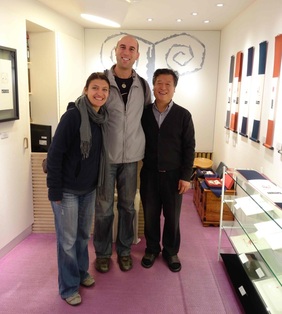 After our class we walked along the famed Insadong Street, known for its art galleries and craft stores. We found an artisan who specialized in a unique type of calligraphy in which he creates his own custom stamps from stone, which he then presses onto parchment. We were enchanted by his portrayal of the 4 Guardian Symbols that were found in Goguryeo-era tombs from about 1000 years ago. In the tombs are beautiful drawings of the Azure Dragon of the East, the White Tiger of the West, the Black Turtle of the North, and the Red Phoenix of the South. We bought parchments of the Azure Dragon and White Tiger to symbolize our adventure from West to East and back again! 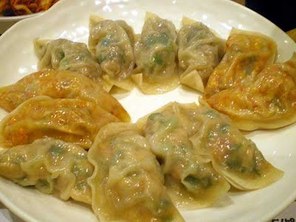 After that big cooking class, dinner was at a little hole in the wall serving a Korean classic – the dumpling (in Korean called Mandu)! We got a sampler that contained the whole variety. The classic steamed dumpling stuffed with minced meat, green onions, garlic and ginger was delicious. However, the Japchae Goon Mandu (deep-fried dumpling stuffed with sweet potato noodles and seasonings) was stellar as was the Kimchi Mandu, a dumpling stuffed with minced meat and kimchi. Bibimbap The next morning we had what may be my favorite of all the Korean dishes mentioned thus far. Our first experience with Bibimbap came not in Korea, however, but in Austin. It was there that our friend Catherine (who is half Korean) served it to us after teaching us a great Anasura-based yoga class. Literally meaning “mixed rice” bibimbap consists of a bowl of warm rice topped with sautéed and seasoned vegetables such as shitake mushrooms, spinach, carrots, and bean sprouts along with seasonings of chili pepper, soy sauce, sesame seeds, and garlic. In the middle is a raw egg that cooks as you mix it in with all the ingredients. In Seoul we found a place doing a slight variation called dolsot bibimbap, or “stone pot mixed rice”. The whole dish comes out in a hot stone bowl and the rice becomes slightly crispy as the whole thing cooks into an unbelievably delicious rice & egg mash! It’s truly “Seoul Food”! 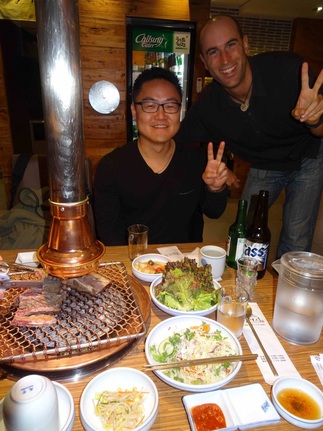 Dinner with Ricky Dinner with Ricky It was fitting that we ate a dish that reminded us of Catherine on this day because later that afternoon we met up with her cousin Ricky, who lives in Seoul. Ricky took us to the Namsan Hanok Village, an area where traditional Korean houses have been preserved to show the architecture of the Joseon era. It was great to meet a local person and talk with him about culture in Korea and what it is like to live in a country that is constantly under threat from its belligerent neighbor to the North. At one point as we were walking down the subway stairs and discussing North Korea, Ricky told us that people in Seoul accept that death is a possibility at any time while living there. He said there is nowhere to hide if North Korea decides to launch an attack, as he well knows having served in the military like every other able-bodied male aged 18 to 35. The interesting thing is that he said it with a sort of fierce pride that implied the people of South Korea had less fear of death as a result of it being so close at hand at any given time. It called to mind our Zen teachings, which tell us that freedom from suffering can be found by being intimate with the fact of our death. It is never easy to have death seemingly loom over us all the time, but it can force a change in perspective that if done in a spiritual way, can lead to more peacefulness instead of less as might be expected 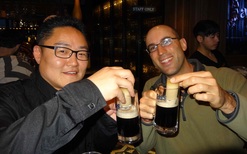 Ricky's first Irish Car Bomb Ricky's first Irish Car Bomb Beyond just the philosophy, we had a great time eating Korean BBQ with Ricky and wandering the city with him. He took us to Itaewon, a part of the city known for its Western bars, where we sipped on high quality tequila and smoked hooka together. He also encouraged us to try Makgeolli, which is an off-white colored beverage made of fermented rice. It is a probiotic laden drink that has a pleasant acidic tang to coincide with its milky flavor. Very unique and another belly booster in Korean cuisine! Tteokbokki The Bibimbap was so delicious that we ate it again the next morning to give us fuel for a full day of city exploration. We started by visiting the 1,200 year old Bongeunsa Zen Temple that features beautiful old temple buildings and a huge statue of the Maitreya Buddha. But the most striking thing about Bongeunsa was the many practioners in the main hall that were engaged in meditation or prostrations. In Japan we had never seen lay people doing these sorts of activities and it was very refreshing to see it here in Korea. We grabbed some cushions and sat in meditation with others, soaking in the pleasant atmosphere of the ancient place. From there we walked down to the Seolleung Royal Tombs, which are 500 year old burial mounds that contain Kings and Queens of the Joseon Dynasty. The park provides a pleasant break from the bustle of the city and the carved statues of horses, state officials, and other animals guarding the tombs were intricately carved and well preserved despite their age. 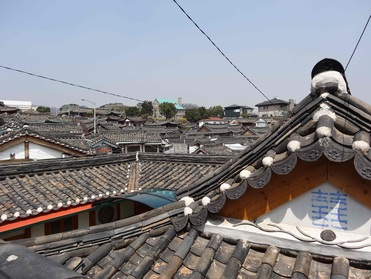 Roofs of Bukchon Roofs of Bukchon The next day we relaxed before taking to the streets to walk the Bukchon neighborhood, which contains hundreds of old Joseon-style houses lining narrow streets that are criss-crossed with even narrower alleys. The beautiful old roofs shined under the mid-day sun and made us feel like we had traveled back in time a bit. While talking about walking the streets, I wanted to make mention of one of the most popular street foods we sampled while in Seoul – tteokbokki (see pic above). Consisting of sliced rice cakes soaked in a spicy red sauce along with minute amounts of meat, this one wasn’t a hit for me. The rice cakes are quite chewy and the sauce lacked the flavor I had come to expect from Korean cuisine. Originally tteokbokki had much more meat, veggies, and eggs and was served topped with ginkgo nuts and walnuts. Those versions sounds great, but I’ll have to give the street version we had a solid thumbs down! Kimbap No need to end on a low note, however as we still haven’t reached the pinnacle of on-the-go Korean innovation – kimbap. Clearly originating from the years of the Japanese occupation, kimbap resembles a Japanese sushi roll, but has several distinct differences. Firstly, while sushi rolls in Japan tend to have only one or two ingredients inside, kimbap is more like “American sushi” being stuffed with cooked egg, daikon, cured meat & cucumber. There are other varieties, but this is the kind we saw the most, and it only cost about $1.50 for a big stuffed roll – which we saw many folks lining up for in the morning on their way to work. Kimbap also differs from sushi because instead of using rice mixed with vinegar, it is mixed with sesame oil, which imparts a nutty and delicious flavor to the whole roll. We ate it often and loved it, including two rolls a piece that held us over during our long haul from Seoul to Istanbul. That’s right folks – the eastern swing is over and we are headed back to the West. A grueling 20 hour flight (with stops) awaits as we excitedly head to the cultural capital of Turkey to meet up with Neda’s parents and start the journey home. See you there! To see all the pics of our time in Seoul, click here:
Kyoto and its environs was our last major stop in Japan and many argue it is the most interesting area of the country. The seat of imperial power from 764 until 1869, it is one of the few cities in Japan spared from the ravaging air raids of WWII, leaving much of its historical legacy intact. During our time in the city, we visited an enormous amount of temples and palaces – a sort of sightseeing marathon that pushed us to our physical limits as we neared the end of a very long travel leg. In the end, however, we found that the lasting impressions were not of ornate palaces or the architecture of the temples, but rather of the tiny monochrome pebbles flowing through the gardens of the city. 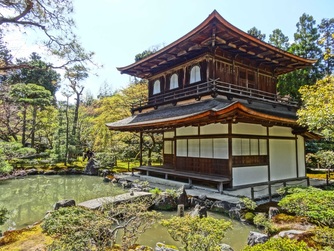 Our first Zen temple was Ginkakuji, sometimes called the Temple of the Silver Pagoda. Built in 1482 as a retirement villa for Ashikaga Yoshimasa, the aged, bared wood of the two story pagoda sits serenely overlooking a pond within an evergreen garden. Offset to the pavilion is the Ginsyaden garden, a bare rock landscape sculpted to resemble waves and the Kogetsudi, a white sand funnel shaped like Mt. Fuji. In this garden we see metaphor and reality playfully intertwined. The resemblance to an ocean and a mountain are unmistakable in the forms of the rocks, and yet are they not just rocks? The Zen garden invites us to see how we assign meaning to everything in our world while also prompting us to see the emptiness of that meaning. It is not a denial of meaning so much as recognition that sitting alongside our world of meaning is one much simpler and straightforward – the world simply as it is. Despite its apparent clarity, it can actually be quite difficult to see this world as it is – we so easily fall back into only our world of constructed meaning. A visit to Kiyomizu Temple challenged how dedicated we must be in order to see this world as it is. The temple is built on a steep cliff in eastern Kyoto with its main porch and altar facing directly off a 50 foot drop onto the ground below. It calls to mind a famous Zen Koan, by Mumon: 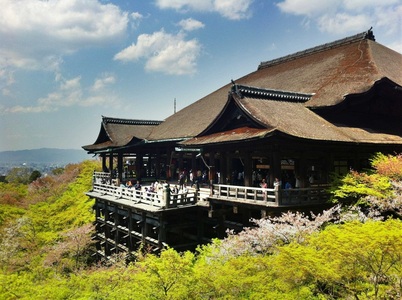 “There is a man on top of a hundred-foot pole. Though he has a degree of understanding, he's not yet a man of the Way. From the top of the hundred-foot pole he should advance a step further and the ten directions of the world will be his entire body." In this koan, a man climbs to the top of a 100 foot pole and is told by his teacher that to advance to enlightenment, he must just climb a step further up the pole, which of course doesn’t exist. Or does it? The implication is that to see the world as it is, we must be willing to cast off our closely held ideas of reality and take the plunge into the unknown, leaving body and mind on the pole, as it were. In the case of Kiyomizu, this may have been taken a bit too literally. It was believed that jumping off the porch would grant the jumper a wish. During the Edo period, 234 jumps were recorded, but only 85.4% survived. Ouch. 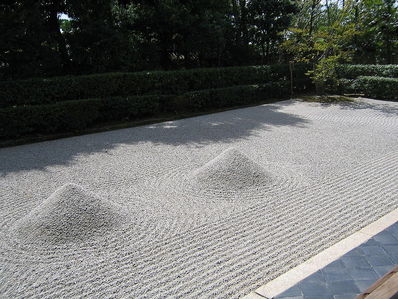 Next we visited Daisen-In Temple, which is within the Daitoku-ji Temple complex in northern Kyoto. The Muromachi period garden is famous for its metaphorical representation of the human lifecycle, starting from the vividly three-dimensional Mt. Horai (land of the immortals in Daoism) and moving past various symbolic naturalistic representations of the lessons we must learn to move towards enlightenment. A turtle-shaped rock, for example, appears to flow against the stream of the river, symbolizing the futility of fighting time, while a treasure boat shaped rock floats serenely with the river towards the Great Ocean. It is this ocean that was most captivating to me, a long stretch of carefully raked pebbles broken by only 3 objects. Closest to the viewer are two conical piles of stones rising out of the sea. They represent our brief moment of individuation from the Great Ocean. Beyond them, in the far corner sits a small bodhi tree. The message was vivid to me - we must return to the ocean, allow ourselves to dissolve back into the Great Sea, to find the other shore of enlightenment. Perhaps Zen master Tessho said it best in his death poem: Finally out of reach - Our last rock garden was perhaps the most famous, the 15 stones of Ryoanji. Here we come full circle, for the rocks at Ryoan-ji are said to represent nothing at all in the natural or mythical world. Here a rock is just a rock. The composition of the stones was designed to absorb the viewer, making him/her more conducive to the meditative state. We leave the realm of metahpor that our ego-minds dwell in 24/7 and come fully to this moment. In the end, no level of thought can help us to arrive there. But the message of Ryoan-ji is that inspiration towards “suchness” is to be found in all the myriad forms that surround us in day to day life. If there is “good news” in Buddhism, it is this. The world is full of suffering, yes – but it also offers infinite pathways to freedom and the relief of that suffering. In the end the paradox of the Zen Garden is that they represent BOTH nothing AND something. It is to live simultaneously BOTH in this world of meaning AND in the world of suchness. Some early historians mistook Zen for a nihilistic tradition, but the truth is that Zen is not a tradition of neither/nor, but rather one of both/and. Beyond the inspiration of the gardens our time in Kyoto was full of historical sites as well. We enjoyed the architectural paranoia built into Nijo castle with its “nightingale floors,” which are designed to squeak like the little birds with even the slightest footfall. Built by the great shogun Tokugawa Ieyasu, founder of the long-lasting Tokugawa Shogunate, the palace shows the fear that even great leaders lived under in feudal era Japan. But it also demonstrates the beauty they lived with, as represented by the captivating naturalistic paintings of the Kano painters and the intricate gardens on the grounds. Being home to the Emperor for so long, Kyoto’s Imperial Palace was also fun to stroll around, particularly to see the beauty of the Gonaitei, the Emperor’s private garden and the Oikeniwa, a stroll garden that offers different perspectives as you walk. The buildings themselves were largely reconstructed after fire in 1855, but were still interesting because of the relationship between the Emperor and Shogun during this time. The Emperor was effectively held hostage to the shogun’s demands over a 500 year period, sometimes even having to sign an “Imperial Decree” just to feed the royal family. 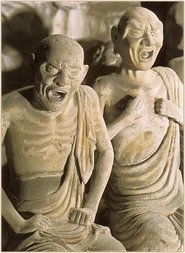 From Kyoto we spent a few days in Nara, the first capital of Imperial Japan from 710-784. The most notable sight lies outside the city in the form of the first Buddhist Temple ever built in Japan – Horyuji. Its builder, Prince Shōtoku, is still venerated in Japan as the progenitor of Japanese Buddhism. It contains the world’s oldest surviving wooden structures, dating from 711. Our tour with a local guide who was practicing his English gave us innumerable insights into the majestic old pagoda, which features various Buddhist scenes at its base. The most striking scene is that of the death of the Buddha, where his disciples are depicted as agony stricken over the loss of their teacher. 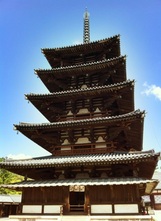 Japan experiences over 1000 earthquakes a year, a fact brought home to us as we awoke at 5:30 in the morning to our swaying hotel as a 6.3 magnitude shake reverberated out from Osaka. Pretty scary when you’re on the 12th (and top) floor of a hotel! Amazingly, the Pagoda’s engineering has made it impervious to such quakes over the centuries, leading its engineering principles to be studied and replicated in modern-day buildings. 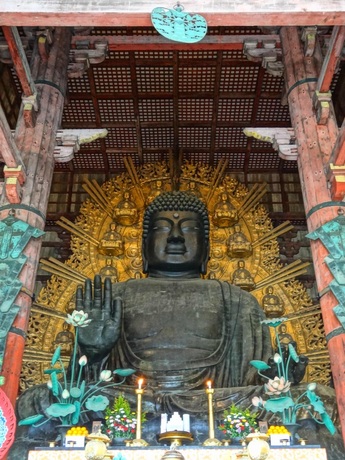 The massive Daibutsu statue The other highlight of Nara is Todai-ji temple, which contains the Great Buddha Hall, or Daibutsuden. It was reconstructed in 1709 and its predecessor was said to be 30% larger still than the current building, which already ranks as the largest wooden structure in the world! But the real highlight is what the Great Buddha Hall houses...a Great Buddha of course! Towering 52 feet high, the Daibutsu is made up of 437 tons of bronze, 286 pounds of pure gold, and 7 tons of vegetable wax. It was commissioned by Emperor Shomu, who believed that if all the people of Japan joined together to make this Buddha image, it would encourage the Buddha to protect their kingdom. As a result, more than 2.6 million people worked on the construction of the Buddha and the hall over the years it took to build the structure and the eight castings required to get the bronze to take shape. In the end it nearly bankrupted the kingdom, so maybe the Buddha was sending a message that he doesn’t care too much about giant images, particularly since he explicitly said not to worship him after his death...tsk, tsk Emperor Shomu! 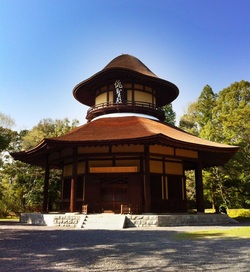 Haiseiden - Basho Memorial Our last real tourist stop in Japan was the birthplace of Matsuo Basho, the famous Zen poet who we featured in our Tokyo post. The town features several museums on Basho as well as his childhood home, but unfortunately all of them are in Japanese. Fortunately, there was another tourist attraction nearby that didn’t require much English because Iga-Ueno is also famed as the birthplace of Ninjitsu! During the month of April the city hosts a Ninja festival where everyone in the town is invited to dress up as a ninja (for a $10 fee) and test themselves with various feats of agility and dexterity. While we had had enough dress up for one trip with our samurai and kimono stint, we had a great time watching the kids and marveling at the little ninjas the town had discretely placed all along the street. 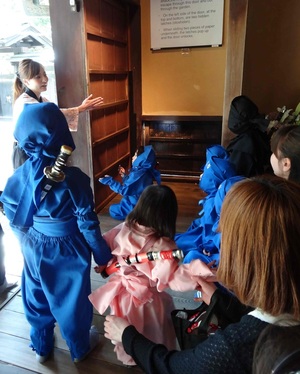 Ninja house tour with little ninjas We also enjoyed the Iga Ninja museum, where we learned about the way Iga-Ryu Ninjas trained and practiced. Apparently, it was common for them to disguise themselves as farmers until called upon by a liege lord to commit an act of espionage - be it reconnaissance, diversionary tactics, or assassination. As such, they would combine typical farmer’s scythes to make grappling hooks and had interesting ways of hiding their weapons. This was really emphasized in the tour of a typical ninja house, which is full of hidden doors and escape passageways that aim to provide the ninja a fast exist but also to hide his secret technique for producing gunpowder (a powerful military secret at the time). Of course, no ninja museum is complete without a live show performance featuring shuriken throwing and mock fighting. The ninja festival was too cute to not include a few extra pics. Here are some of our favorites: 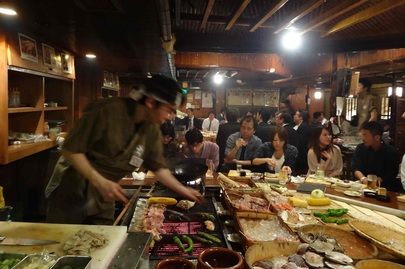 Izakaya in action Finally, it was time to turn the page on our Japanese adventure. We headed to the city of Osaka excited due to its reputation as the food capital of Japan. It didn’t disappoint as we ate our fill of sushi-train (invented in Osaka along with the instant noodle in 1958), okonomiyaki (also invented there), and izakaya foods. The izakaya we enjoyed with a couchsurfer named Nathan who was living in Osaka and agreed to meet up with us to show us around town a bit. Izakaya is basically live action grilling combined with the consumption of large amounts of beer. What’s not to like? After dinner, Nathan showed us a cool little brew bar that served up delicious cask-pulled IPA’s and stouts. Thanks buddy! We also enjoyed the parks around Osaka Castle and particularly the Japanese mint as it contained a variety of late blooming double-pedaled cherry blossoms that gave us yet another glimpse of these wonderful trees so important to the Japanese national psyche. Our time in Japan was full of rich experiences – from the reminders of our cherry blossom nature to connections beyond words with our Japanese family in Shiojiri. From the historical pensiveness engendered by Hiroshima to the contemplation stimulated by the gardens of Kyoto. We feel nostalgic about our time here but are also excited as we head to Japan’s neighbor, South Korea, for a 6 day stopover for some Seoul food! See you there!
In Buddhism, there is a worldview which posits 6 realms of existence through which human beings move during their cycles of reincarnation. In American Zen thought, these realms are not considered to be real places, but allegories of how we keep ourselves in “dukka”, or suffering. I remember a wonderful talk by AZC senior lay-practioner Pat Yingst on these realms of existence where she suggested that in any given day we could move through all 6 realms as we found various ways to divide ourselves from the present moment – to keep ourselves alienated from the world around us. As we visited Peace Park in Hiroshima, the site of the dropping of the first atomic bomb on August 6th, 1945, I felt like I was moving through all 6 hell realms as I tried to understand the the reasons for it being dropped and the devastation that ensued. At first I felt it was entirely unnecessary to drop the bomb and at other times I wasn't so sure. The fact is, it was a messy situation with many different factors involved. In order to capture this experience, we will look at each realm and how it may connect within a historical context to the first half of 1945, when Japan was losing the war but unable to come to a peace agreement with the allies. 1. The Realm of Devas (Gods) and Heavenly Beings The Deva realm is populated by godlike beings who enjoy great power, wealth and long life. They live in splendor and happiness. Yet even the Deva grow old and die. Further, their privilege and exalted status blind them to the suffering of others, so in spite of their long lives they have neither wisdom nor compassion.” The fanaticism of powerful aspects of the Japanese military government seemed to be residing in this realm, where they were completely disconnected from the suffering of their people. Even as Japan’s navy lay destroyed and surrender seemed inevitable, the Big Six or Supreme War Council in Japan, declared a formal policy of the "honorable death of the hundred million" - national suicide. 2. Asura-gati, the Realm of Asura (Titans) The asura realm is populated by powerful beings who experience a life that could be almost as pleasurable as that of the devas in the heaven realm. However, the asuras are very envious and suspicious of each other and the devas, so they spend their time absorbed in great wars and conflicts instead of enjoying themselves. The realm is full of assembling armies and asuras in battle gear. Even though they value justice, wisdom and faith, they always desire to be superior to others, so they are competitive and egotistical. Sounds a bit like the cold war, huh? The Hiroshima Peace Memorial Museum outlines how during the February 1945 Yalta Conference including Roosevelt from the US, Churchill from the UK, and Stalin from the USSR, the USSR agreed to enter the war against Japan three months after a German surrender. The US and UK made concessions to achieve this agreement, like granting the USSR railways in Manchuria and Port Arthur. But once the atomic bomb was successfully tested in the Trinity test of July 16th, the US began to fear that the Soviet Union entering the war and providing the decisive step in the surrender of Japan might lead to their expansion of influence throughout the Pacific. They wanted to limit Soviet control and a belief was that dropping the bomb might cause Japanese surrender prior to the Soviet Union entering the war. So with their mistrustful power struggle as a motive, over 100,000 people died unthinkable deaths as the heat, radiation, and shockwaves poured over an entire city. 3. The Human Realm The Human Realm is the only realm of the six from which beings may escape samsara. Enlightenment is at hand in the Human Realm, yet only a few open their eyes and see it. Rebirth into the Human Realm is conditioned by passion, doubt and desire. It’s ironic that the military commanders of Japan claimed they would not surrender unless the Emperor system was retained in Japan. Some argue that by the Emperor system, they simply meant the old militaristic order in Japan, which they controlled. The Japanese Ambassador to Russia, Naotoke Sato, wrote to the Big Six prior to the bombing that an unconditional surrender with the sole proviso of the preservation of the Emperor would probably even be accepted, but the Japanese leadership refused to consider it. Why? The military were all to human in holding onto their positions of power at the cost of their own people, even when given the choice to have the Emperor remain in some position of authority (which he did after the war). 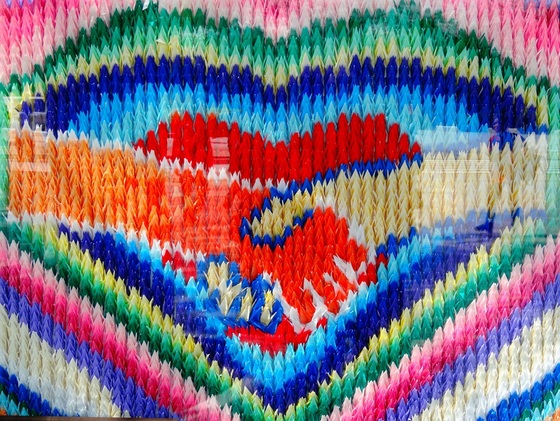 Paper cranes at the Children's Peace Monument honor Sadako Sasaki, who was exposed to the bomb at the age of 2 and seemed healthy until developing Leukemia 10 years later. She attempted to fold a 1000 cranes in the hope it would help her recover. per old Japanese folklore. Sadly, she only reached 644 before dying on October 25, 1955. Her friends and family finished the cranes for her and now children all over Japan fold in her memory. 4. The Animal Realm Animal beings are marked by stupidity, prejudice and complacency. They live sheltered lives, avoiding discomfort or anything unfamiliar. Rebirth in the Animal Realm is conditioned by ignorance. People who are ignorant and content to remain so are likely headed for the Animal Realm, assuming they aren't there already. Even after both bombs had been dropped and the Soviet Union entered the war against Japan, the Army (led by minister Anami, who committed suicide after the war) was unwilling to surrender, wanting to make terms that were more favorable to Japan. There was even a coup, called the Kyūjō Incident, where hardline factions within the military attempted to assassinate key parties to prevent surrender. With this sort of fanaticism, even in the face of clear defeat, was there any choice about whether to drop the bomb? The Army held a crucial seat on the Big Six and could effectively block any entreaties for peace, which they did even after both bombs were dropped. Only the Emperors intervention ordering them to make peace eventually forced Japan to surrender. 5. The Realm of Hungry Ghosts 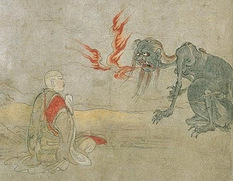 Hungry ghosts (preta) are pictured as beings with huge, empty stomachs, but they have pinhole mouths, and their necks are so thin they cannot swallow. A hungry ghost is one who is always looking outside himself for the new thing that will satisfy the craving within. Hungry ghosts are characterized by insatiable hunger and craving. They are also associated with addiction, obsession and compulsion. The Manhattan Project was achieved at a cost of over 2 billion dollars and the work of over 120,000 people. It was a massive expenditure of resources and those behind it, like Director of War Mobilization James Brynes, worried that if the bomb wasn’t used and proved effective, criticism and investigation would follow. The Secretary of War, Stimson, supposedly said to President Truman that he worried that the already bombed out Japanese cityscapes would prevent the US military from measuring the true effectiveness of the weapon. Thus, potential target cities were not subject to air-raids in the months before the bombing. 6. The Hell Realm 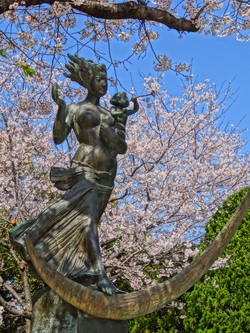 As the name suggests, the Hell Realm is the most terrible of the Six Realms. Hell beings have a short fuse; everything makes them angry. And the only way hell beings deal with things that make them angry is through aggression -- attack, attack, attack! They drive away anyone who shows them love and kindness and seek out the company of other hell beings. Unchecked anger and aggression can cause rebirth in the Hell Realm. Despite having no bargaining chips, the Japanese military developed the Ketsu-go strategy, which was to have such a fierce defense of the Kyushu beaches that Americans would take incredibly heavy casualties on their first assaults of the Japanese mainland. They hoped the Americans would blanch at such losses and negotiate peace in a way that would grant the military continued power over Japanese society. Still, there is belief among some historians that even without the use of the atomic bomb, which killed between 90,000–166,000 people in Hiroshima (of acute symptoms alone) Japan would have surrendered. This assumes a continuation of the conventional air raids that had already pulverized most of Japan’s cities. We have seen the results of this as we travel around the country to find most of the gardens and castles to be reproductions built since the war. Amazingly, by March of 1945 “conventional” warfare was nearly the equivalent of the atomic bomb in destructive capacity. Waves of small napalm like bombs were dropped onto the city’s civilian population and the fires spread and connected into a huge firestorm that sucked all the air out of the atmosphere. In one such raid in Tokyo, 125,000 people perished. The Allies bombed Hamburg and Dresden in the same manner, and Nagoya, Osaka, Kobe, before then bombing Tokyo a second time. Well, we’ve moved through the six realms of human existence and examined the different aspects of the decision to drop the bomb on Hiroshima. For me it was an incredibly emotional experience to read about the abstract decision making on the part of both sides but to then so viscerally see the effects of those decisions on the innocent civilians of Hiroshima. So often it is the least of us who suffer for the ignorance and delusion of the powerful. We've shared many of the pictures of the Hiroshima Peace Park & Museum above, but to see all the pics of the area as well of Miyajima (mentioned below), click here: 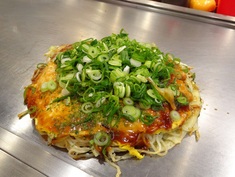 Feeling a bit somber after the museum and exploration of Peace Park (which you’ve seen in pictures above), we headed off to the famous institution of Okonomiyaki-Muri, where there are 3 floors of cooks all dishing up the Hiroshima version of the Japanese pizza/omelet. All the cooks entreated us as we looked at the different stalls, which featured Okonmiyaki made up of layers of ingredients instead of mixed together. 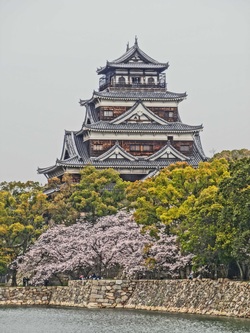 The next day we paid a visit to the rebuilt Hiroshima Castle, where we learned about the different construction styles of castles throughout Japan. This ranges from mountaintop castles built for defense in the early days of the Shogun to later peace-time castles built on flatlands that served mainly administrative functions. Then we took the ferry over to the famous Miyajima Island, right off the coast of Hiroshima in the Seto Inland Sea. The island is famous for the Itsukushima Shrine, a Shinto shrine with a beautiful Torii gate that appears to float in the water at high tide. We also enjoyed the Shingon Buddhist Temple of Daishoin, which features a cave symbolizing the entire 88 temple pilgrimage route of Shikoku and humorous Buddhist related statuary like the five hundred Rakan (many of which sported adorable quilted hats). The colorful temple also sported a long nosed Tengu (mountain spirit and defender of the dharma) and fierce looking Myo-o Buddhas who are committed to “encouraging” humans to follow Buddhism. Glad I didn’t meet one of them when I first started meditating! 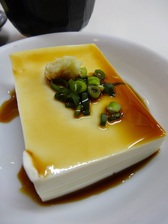 Mmm...tofu From Hiroshima we took another trip on the Shikansen to arrive in Okayama, famed for its Korakuen Garden. Hungry for lunch, our first stop was at Okabe Restaurant, which specializes in home-made tofu. Oishi! (Japanese for delicious). Then onto the park, which was full of cherry blossoms in full bloom. One of the most interesting features of the garden is its use of "borrowed scenery", incorporating the nearby Okayama Castle into the various views you experience as you stroll along its paths. But the highlight may have been after the garden, as we walked along the Asahigawa Sakuramichi Walk, lined with over 250 Someiyoshino cherry trees in full bloom. The trees were lined with revelers having hanami parties (cherry blossom viewing parties) so we figured, “when in Rome!”. We bought ourselves some snacks and beers and sat down under the trees to enjoy them Japanese style! 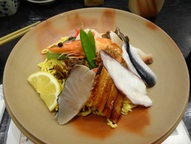 The next day brought rain and a day to relax (and for me to write this blog). We also had an excellent lunch sampling the local specialty of barazushi and a wonderful dinner with duck cooked on a charcoal grill and cold soba salad. Perhaps most charming in this small town was how the servers at both places we ate dinner walked outside to say goodbye to us, making us feel like family. Despite the sordid history discussed in this post, traveling through Japan today certainly seems more like traveling through the Deva realm rather than the hell realm it had become by the end of World War II. But maybe by remembering how easily we can move from one realm to the other, in our individual lives and in our national policy, can help avoid such wanton destruction in our future.
For all the pictures of Okayama & the Korakuen Garden click here: |